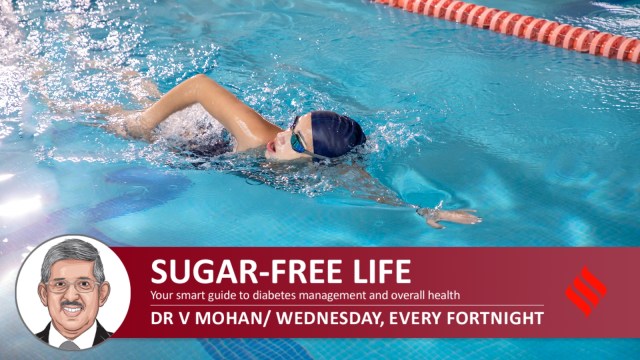Can blood sugar control be made easy? Try swimming, it may be the best exercise
AHIIT or aquatic high-intensity interval training may become a practical routine to keep to your goals, says Dr V Mohan, Chairman, Dr Mohan’s Diabetes Specialities Centre, Chennai
 Once you build muscle mass and reduce fat build-up in the body, you can control diabetes and hypertension together. (Representational image via Canva)
Once you build muscle mass and reduce fat build-up in the body, you can control diabetes and hypertension together. (Representational image via Canva) A few days ago, I came across a study in the BMJ Open Sport & Exercise Medicine which found that high-intensity interval training in water, often called aquatic high-intensity interval training (AHIIT), improves exercise capacity in adults with chronic conditions such as diabetes and arthritis.
The logic is simple. First, many people find it difficult to set aside 30 to 40 minutes of exercise and choose a short burst of high-intensity routine of 15 minutes to achieve their weight loss, and by extension, sugar control goals. Second, the buoyancy of water provides a natural resistance while minimising joint stress, allowing people to do exercises that they wouldn’t otherwise be able to do on land. And AHIIT, which involves a pleasurable but wholesome activity like swimming, works the whole body and muscle groups. This improves insulin sensitivity, prevents insulin resistance and bolsters cardiovascular health. Once you build muscle mass and reduce fat build-up in the body, you can control diabetes and hypertension together.
Since most Indians are not naturally prone to HIIT and some are even hesitant to go to gyms, we have culturally adopted HIIT through dance at our centre, precisely through the tandav. This dance form has been pilot-tested by us, has been found to be efficacious for 12 minutes and has had cascading effects on obesity, diabetes and even mental health as it activates happy hormones like endorphins.
Physical activity versus exercise
Physical activity is any body movement produced by skeletal muscles that results in energy expenditure beyond the resting expenditure. Exercise is an activity that is planned, structured, repetitive and purposeful, usually aimed at improving or maintaining physical fitness.
Benefits of exercise in diabetes
📌 Prevention of Type 2 diabetes
📌 Maintenance of glycemic control
📌 Prevention of diabetes complications
📌 Additional benefits like lower bad cholesterol, higher good cholesterol, reduced blood pressure and weight.
HIIT is just one part, you need F.A.R to control diabetes
There are three types of physical activity that one should do. Flexibility, Aerobic Exercise and Resistance Training (FAR). HIIT falls under the category of aerobic exercises. And we need to do exercises from the other two categories for total diabetes control.
1. Flexibility leads to better balance. Older people tend to fall easily and thus are prone to fractures. This can be avoided if one’s flexibility improves.
2. Aerobic exercises include walking, jogging, swimming, cycling, dancing and various games. They involve the utilisation of oxygen by the tissues and also increase our heart rate.
3. Resistance training : An example of this is lifting small weights. These can be done as 10 to 15 repetitions and help build muscles.
What is the right routine for people with diabetes?
1. Do a ‘warm-up’ with stretches and ‘cool down’ for about five minutes each.
2. Exercise regimens have to be highly individualised. Build up step by step and increase your fitness and stamina. This will help control not only diabetes but other co-morbidities as well. Follow the FITT principle:
Frequency – at least five days/week
Intensity – moderate
Type – aerobic + resistance + flexibility
Time – for at least 30 to 45 min at a stretch
How much should one exercise?
The recommendation is to have at least 30 minutes of exercise, for example a brisk walk, at least five times a day, amounting to a minimum 150 minutes per week.
What’s the right amount of exercise?
One should still be able to talk or sing while doing exercises. In other words, don’t overdo it.





- 01
- 02
- 03
- 04
- 05


























